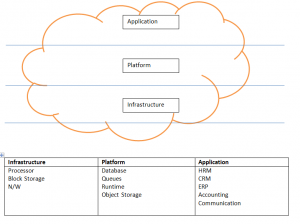The cloud has become an integral part of the IT strategy of most large corporations, but for many small businesses & start-ups, it is still an unknown commodity. The benefits of cloud computing services in terms of business agility, financial prudence, etc, are pertinent for large corporations as well as start-ups and small businesses. But there are still many small businesses not completely sure about what is meant by cloud computing and where it fits into their IT strategy.
What is Cloud Computing?
To really understand how the cloud is beneficial for small businesses, let’s first understand what cloud computing really is:
Cloud computing is a mechanism by which computing resources are available online. The computer resources can be in the form of data centers, processors, system-level software, or application-level software. These resources are shared and available on demand. These resources can be either publicly available or private (for use only within an organization).
The cloud computing levels are:
Infrastructure
- Processor
- Block Storage
- N/W
Platform
- Database
- Queues
- Runtime
- Object Storage
Application
- HRM
- CRM
- ERP
- Accounting
- Communication
The importance of Cloud Computing levels mean for a Small Business or a Startup
For a small business or a start-up arranging all the physical computing resources can be costly. Startups and small businesses are always concerned about the cost. Physical resources (Infrastructure layer) most times consume the bulk of the cost of setting up a startup or expanding a small business. It is here that the infrastructure layer of the cloud can be particularly beneficial. Instead of setting up separate servers or data centers, one can actually get these resources when required, on-demand, by using the cloud. As a small business or a start-up, the cloud gives immense flexibility. If required you can scale up really fast and also on the flip side, you can immediately cut costs by unsubscribing to unnecessary computing resources.
Quite often when we are setting up our business we provision for peak demand. So if we feel that we might have X amount of peak data requirement, Y amount of peak processor requirement, and Z amount of Peak N/W port requirements. We would actually provision for X, Y & Z. However, the actual average utilization of these resources might be X/4, Y/4, and Z/4. This means most times the resources are ideal. Now if we were on the cloud and utilizing the infrastructure layer, we would be having the flexibility of using just as much as we require.
The actual hardware and its complexity are hidden from the subscriber in this case. Virtual machines are being created in the background and provide this infrastructure. A Hypervisor runs this virtual machine. In simple terms, a Hypervisor is a computer that is running many virtual computers. It is allowing for the sharing of resources, such that it is possible to run multiple Linux, Windows, and OS X instances on a single physical x86 machine. An alternative to Hypervisors is Linux Containers which do away with the need to have separate computers (hypervisors) which are overhead.
The management of this Virtual hardware is the headache of the infrastructure layer service provider. These additional human resources who manage IT infrastructure may not be required in-house.
The platform layer provides databases, queues, temporary storage, etc, which can be used by application developers to develop software that can run on the cloud. Thus the underlying complexity of buying and managing hardware and software can be removed. Microsoft Azure & Google App Engine provides platform layer offers that will automatically scale with the application’s requirement of databases, queues, etc. Thus small businesses and start-ups that have limited budgets and resources can use such an offering to their advantage. Also because of its pay-as-you-go mechanism, it allows for the cost to be spread over a period of time.
Finally, the Application layer is a way to get on-demand software. This software can be any of the business requirements that the business might have: CRM, ERP, HRM, Accounting, etc. Instead of developing this or installing it on the system, the software can be got on demand. Even the cost of maintaining the software is provided by the service provider.
The pricing model for this is monthly in general and again gets spread out instead of being a one-time payment. This is again a huge benefit for small businesses. With the application stored centrally, updates can be released without the need for users to install the new software.

